
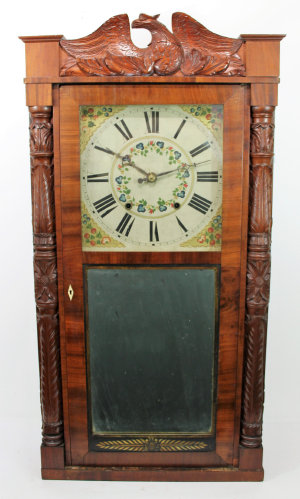
550. $325
Jeromes’ & Darrow Eight-Day carved column and crest shelf clock, 1828-1833. This 36-inch
tall clock has carved columns and an eagle crest and houses an 8-day wooden works movement. The wood dial is very nice with
extensive floral decorations, but needs to be lightly cleaned. The mirror is very old if not original and is inset in a frame
with a worn gold leaf border and a bronze decoration at the bottom. The mahogany veneer is complete. The chimneys and
returns, and possibly the carved eagle splat appear to be replacements. The dial glass is also new and has not been puttied
into place. There is a nice and nearly complete label inside and two new old-stock 8-day weights. We did not test the
movement but it does appear to be ivory-bushed, as specified on the label. The pulleys on the compounded weight cords are metal
and should be wood. $350-$500.
551. $1200
Seth Thomas off-center pillar & scroll, ca. 1825. A refinished case, for sure. The feet and skirt would look to be replacements, based on the stain/shellac applied to them (see the photo). Nonetheless, they
look correct. The tablet was nicely repainted by Mr. Moberg; the scroll top has been re-veneered, and the scroll tips repaired. Again, it looks good. The brass urn finials are correct to Seth Thomas style and old, with metal stems and no seams. The
dial board is adapted from another clock, and not a Seth Thomas, as it lacks the appropriate decoration below the mainstem. The old winding holes have been filled and painted over nicely, but the entire board is dark and needs cleaning. The hands
are pewter and found on some other off-center P&S clocks and so are probably correct. The wood strap movement is correct
but has had some repairs, including the fly; there is no seconds hand, but many of these clocks did not offer this. The
dial glass is very old (as is the tablet) but the putty holding it in place is new. We didn’t test the movement; the weights
are appropriate but the compounding pulleys are metal and are not original (they should be wood). There is not much of a label
left. No, this clock is not perfect by any means, but it certainly approximates the original, looks good, and is priced accordingly. These clocks have been selling for around $1500 in similar condition recently; we haven’t seen a perfect one sell in recent years
but it likely would bring quite a bit more. $1200-$1600.
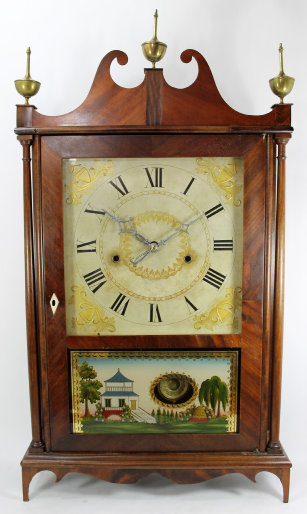
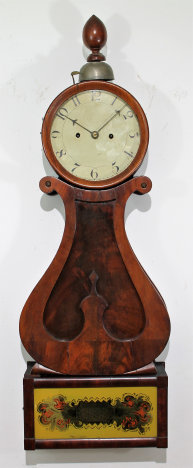
553. $350
Silas Hoadley “Franklin” shelf clock, ca. 1830. A 30-hour wooden works, upside-down movement
clock in a half-column & splat case, 35.5-inches tall. These were called “Franklin clocks” after the label inside and the
Benjamin Franklin quote, “Time is Money” stenciled on the small glass at the bottom of the door. The movement is advertised
as “With the improvement of bushing the pivots with ivory”. Some of these clocks came with an alarm mechanism as well. All came with stenciled half-columns and often the characteristic splat seen here, with a mirror in the full-length door over the
smaller painted glass at the bottom. The glass in this clock was repainted by Tom Moberg; it is cracked on the left side, barely
noticeable. The glass is old, the mirror period if not original. The dial glass is new, held in with wood strips, and
the dial board is adapted from another clock with the old winding arbors filled and new ones drilled above the mainstem. The
dial has been repainted, the hands are newer but correct to style. The stenciling on the splat and columns is faint, but original,
and the mahogany veneer is in good shape throughout. Two old 30-hr weights and an old pendulum bob, and a label behind plastic
in reasonable condition. We did not test the movement, but it looks complete and functional. These clocks are not uncommon
and have been selling for $300-$400 for some time; they remain popular due to the unusual upside-down movement and the “time is money”
aphorism on the glass.
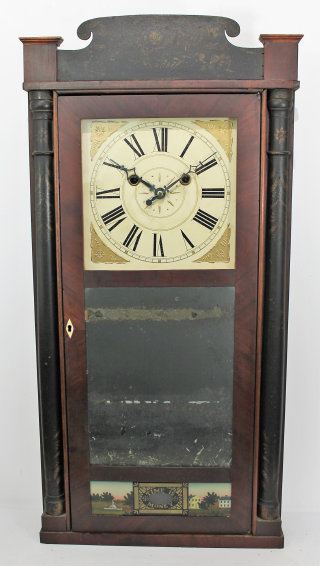
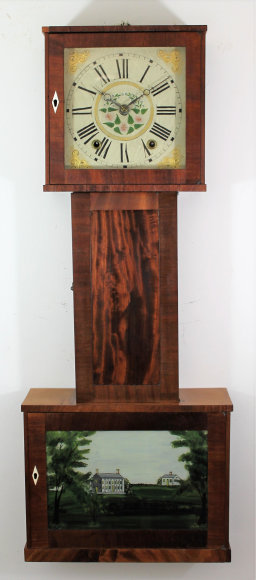
554. $1300
Terry wooden works banjo, ca. 1830. There are five examples of this model in the Antique Clocks
Price Guide over the last 18 years – not a common clock. It has a 30-hour wood movement and a short drop (5-inch) pendulum. The length of the case, 35 inches, is to allow for the two weights to fall. This exact clock, owned by John Delaney at the time,
is pictured and described in Petrucelli and Sposato’s book “American Banjo Clocks” on page 158. It is described as a “Terry
type” striking Connecticut banjo. Only one has been found with a label, apparently for “Terry & Sons”, although others
have attributed these clocks to Henry Terry. One account suggests that Eli Terry wanted a clock to compete with the very popular
banjos being made in the early 1800’s. It is a clever use of available materials, but it didn’t catch on. The mahogany-veneered
case has three doors (two with ivory escutcheons) a wood dial typical of Terry clocks (with original paint), Terry-type hands, two
old 30-hour weights, and an acceptable but not outstanding repainted tablet. Both glasses are old, the dial glass appears to
be so old that it may be an art-glass replacement from 50+ years ago. We hung the weights and the clock would strike, but we
didn’t get it running. You probably can if you want, the movement looks complete. Schmitt’s sold one in 2012 for $1300,
the most recent sale. Earlier sales went for quite a bit more. $1300-$2500.
555. $725
Seth Thomas “Empire No. 30” crystal regulator, 1905. This uncommon crystal regulator stands
12.5 inches tall on machined bun feet with four cut-glass columns and cut-glass plates around the top and base, as well as on top. There are four beveled glasses. The brass case needs a bit of polish if you want it to shine. The 4-inch porcelain dial
is signed and decorated with a floral wreath in typical Seth Thomas fashion. The round movement is billed as “high grade, 15-day,
hour and half-hour rack strike”, with an imitation mercury pendulum; we had the movement dissembled and cleaned and it is running,
striking, and keeping time. It strikes on a cathedral gong. No sales records in the Antique Clocks Price Guide, so clearly
not common. $750-$1000.


552. $$3500 $3000
Early lyre banjo with bell, ca. 1830. An early unsigned lyre banjo
with a bell strike on top in a 33-inch figured mahogany case. Two weights drive the time and strike; the movement will run for
a few minutes, and the strike appears to work with a little push. The metal dial appears to hold its original paint, and the
hands look original as well. The lead weights don’t quite match, and neither do the pulleys. The pendulum assembly
and weight shield may be original, and I think the tablet with gold leaf background is original and in very nice shape. The
top finial is likely a replacement. I think there may have been a tapered base below the tablet box, as the bottom is not veneered
and there are some unexplained holes. Couldn’t find an example of this clock in Petrucelli and Sposato’s book “American Banjo
Clocks”, although similar bell strike models with similar movements are found in the early 1800’s. I found only one sale of
a similar model in the Antique Clocks Price Guide at Cottone’s in 2001 for $9625. That was a long time ago, but there just aren’t
many examples of this style of clock with the bell on top. $3500-$5000.